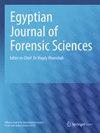法医硅藻学全面回顾:当代发展与未来轨迹
IF 1.3
Q3 MEDICINE, LEGAL
引用次数: 0
摘要
法医硅藻学是一个发展迅速的领域,涉及为法医目的对被称为硅藻的微小藻类进行检查。硅藻是微小的单细胞真核藻类,存在于河流、湖泊、池塘和海洋等各种水生环境中。它们的特点是细胞壁坚硬,由二氧化硅构成,这是一种独特的形态特征,使它们在法证调查中大有用武之地。硅藻是一种单细胞微小藻类,属于硅藻门(Bacillariophyta)。它们是所有水生环境(包括海洋和淡水生境)中最常见的浮游植物之一。硅藻已被证明是各种法医调查中的宝贵证据,尤其是在涉及溺水或从水生环境中打捞出的尸体的案件中。本综述深入分析了与法医硅藻学领域相关的原理、方法、应用和挑战。它强调了硅藻作为痕量证据的重要性,并讨论了硅藻在建立受害者与周围环境之间关键联系方面的潜力。本综述还探讨了硅藻分析技术的一些最新进展,包括分子方法和自动识别方法。最后,本文概述了未来的研究方向,并强调了标准化协议和跨学科合作的必要性,以提高法医硅藻学的可靠性和有效性。本文章由计算机程序翻译,如有差异,请以英文原文为准。
A comprehensive review of forensic diatomology: contemporary developments and future trajectories
Forensic diatomology is a rapidly progressing domain that involves the examination of microscopic algae known as diatoms for forensic purposes. Diatoms are microscopic, single-celled, eukaryotic algae that exist in diverse aquatic environments such as rivers, lakes, ponds, and oceans. They are characterized by their rigid cell wall made up of silica, which is a unique morphological character, making them useful for forensic investigations. Diatoms are a type of unicellular microscopic algae that belong to the class Bacillariophyta. They are one of the most common phytoplankton found in all aquatic environments, including marine and freshwater habitats. Diatoms have proven to be valuable evidence in various forensic investigations, particularly in cases involving drowning or bodies recovered from aquatic environments. This comprehensive review provides an in-depth analysis of the principles, methodologies, applications, and challenges associated with the field of forensic diatomology. It emphasizes the importance of diatoms as trace evidence and discusses their potential to establish critical associations between the victim and the surroundings. This review also explores some recent advancements in diatom analysis techniques, including molecular approaches and automated identification methods. Finally, the paper outlines future directions for research and underlines the necessity for standardized protocols and interdisciplinary collaborations to enhance the reliability and validity of forensic diatomology.
求助全文
通过发布文献求助,成功后即可免费获取论文全文。
去求助
来源期刊

Egyptian journal of forensic sciences
MEDICINE, LEGAL-
CiteScore
2.00
自引率
0.00%
发文量
51
审稿时长
17 weeks
期刊介绍:
Egyptian Journal of Forensic Sciences, the official publication of The International Association of Law and Forensic Sciences (IALFS), is an open access journal that publishes articles in the forensic sciences, pathology and clinical forensic medicine and its related specialities. The journal carries classic reviews, case studies, original research, hypotheses and learning points, offering critical analysis and scientific appraisal.
 求助内容:
求助内容: 应助结果提醒方式:
应助结果提醒方式:


